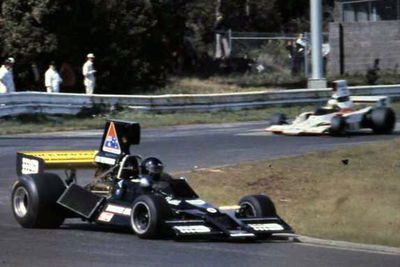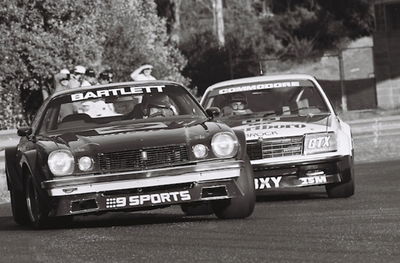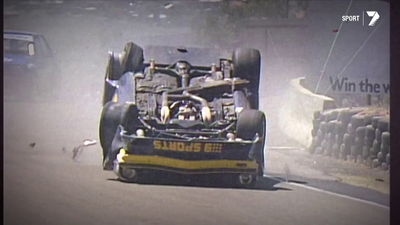Beating the Drums - 1978 Chevrolet Camaro Z/28 Group C #Blogpost
Kevin Bartlett’s 1978 Chevrolet Camaro Z/28 is one of the most memorable Australian touring cars to never win a championship or Bathurst.

Kevin Bartlett’s 1978 Chevrolet Camaro Z/28 is one of the most memorable Australian touring cars to never win a championship or Bathurst. Bartlett had spent most of the 1970s competing in open wheel racing, but with the decline of Formula 5000, he returned the Australian Touring Car Championship in 1980.
Channel Nine owner Kerry Packer had hired Bartlett to look after his performance road cars, and was aware that he was looking to leave F5000. When Bartlett visited Packer in early 1978, Packer suggested that they do something together in touring cars. Packer wanted to see Bartlett racing again and get Channel 9 advertising shown on rival network Channel 7, who broadcast the ATCC and Australian Endurance Championship. The Group C rules were being revised at the time, so they looked at a variety of options to find the car that would give them the best chance of winning.
There were a number of reasons for choosing the Camaro. It had just been homologated under international Group 1 rules, and was a proven race package. The 350ci small block Chevrolet V8 was also essentially a long stroke version of the 5.0 SBC Bartlett had run in F5000. Bartlett believed the chassis stress figures from Chevrolet were good for Group C. Weirdly, Bartlett and Packer received none of the resistance that Allan Moffat did for trying to run a 2+2 seater sports car in the touring car championship. A V8 Chevrolet evidently was a lot more acceptable than a rotary Mazda.

Bartlett purchased the Camaro from Unser Chevrolet in New Mexico in 1978, and imported it to Australia for race preparation. Although some parts could be borrowed from Group 1, Group C was unique to Australia, meaning a significant amount of Australian input was needed.
Before the car could race, Bartlett endured a series of homologation disputes with CAMS. One was the use of rear disc brakes. The Z/28 came with optional discs, but the particular example Bartlett was using had drums. His intention was to run discs but CAMS didn’t like the look of the homologation documents and initially refused. The Camaro would have to run rear drum brakes that were only good for short sprint races.
Another problem was the weight. It initially weighed 200kgs more than D!ck Johnson’s Falcon, the heaviest car in the championship. To save weight, KB fitted fibreglass rear leaf springs, saving 100kg. The other 100kg was saved by carefully going through the car and finding small savings wherever they could. For example, most of the bolts were aluminium.
The Camaro made its debut at Bathurst in 1979. Bartlett, still recovering from an injury, was forced to watch as Bob Forbes and John McCormack took his place. Held back by useless drum brakes, Forbes and McCormack were forced to retire on lap 60.
Kevin first drove the Camaro at round one of the 1980 ATCC at Symmons Plains in Tasmania, where it fared better, finishing second behind Peter Brock’s Commodore. The result was repeated two weeks later at Melbourne’s Calder Park. The car was clearly quick, even without the disc brakes. Continual development of the car delivered a win in round four at Sandown. It was the first ATCC win for a non-Ford/Holden driver since Bob Jane’s 1972 win in a Camaro ZL-1. A second win came at Adelaide International Raceway. Bartlett was disqualified from the final round at Oran Park, and finished second in the championship over a fuel violation. Bartlett claimed that everyone was doing it, but an error from an unnamed crew member meant they were the ones caught. The championship had already been lost before Oran Park, with Brock holding a 27 point lead double what was on offer. Bartlett blamed a combination of factors for missing the championship, including parity and a limited budget.

Things didn’t go nearly as well at Bathurst. In the shootout, Bartlett qualified on pole, but his drum brakes let him down in the race. The first set lasted just 14 laps before being changed. Later on, Bartlett collided with and flipped a lower class Holden Gemini, because he had ran out of brakes again and couldn’t slow down in time. In a post incident interview with Channel 7’s Evan Green, Bartlett blamed CAMS for not allowing him to run rear disc brakes.
“And of course with our stupid bloody CAMS rules not allowing us to have disc brakes in the back this thing just doesn’t stop, it’s bloody dangerous out there without discs. And I just hit him, and just rolled him. You know sure he made a mistake, but in a normal situation I should have been able to slow up enough. This car doesn’t stop, it slows up. That’s the difference”
Following the incident, CAMS allowed the rear discs Bartlett desperately needed. Despite this, he only contested two rounds of the 1981 championship and sat out of Sandown. At Bathurst, expectations were high, and Bartlett qualified on pole again. He battled with Johnson for the lead early, before colliding with the Ron Wanless Commodore. Bartlett described the incident in another Channel 7 interview.
“It’s just a complete and utter nincompoop got in the way and turned right, just went straight across my path and put me straight into the fence and I took him, mate, that guy has to be black flagged, I’m going to punch him in the mouth when the race is over”.

Bartlett was apparently unaware that Wanless was a former Australian boxing champion. The team got the Camaro going again, only for it to be caught in the race ending multi-car pile-up on lap 121.
KB completed in six of the eight rounds of the ATCC in 1982. Picking up a win at Oran Park and thirds at Symmons Plains and Adelaide, to finish equal third with Allan Moffat.
Bathurst 1982. Bartlett and co-driver Colin Bond hsd some early bad luck in practice. Bond was coming into Reid Park when the front left lower ball joint nut stripped. The suspension pulled away and the car was sent into the wall. The car was repaired in time for qualifying, but it wasn’t perfect. Despite missing a third straight pole position, Bartlett and Bond were one of the favourites to win after qualifying fourth. Bartlett started the race and ran close to the front. Fitted with new and grippy 13 inch wide rear tyres, the car was behaving very well until lap 27 he hit the wall at Reid Park and flipped over,sliding down the track. Luckily, Kevin climbed out unharmed. Channel 7 executives watched furiously as their own network ran replays of a car sponsored by Channel 9. At first he thought one of the rear fibreglass springs had failed, but it turns out the wheel rim had split and blown the tyre.

Bartlett drove the Camaro for the final time at Oran Park in 1983, finishing ninth. KB partnered Johnson for the Australian Endurance Championship. Mike Burgmann drove it in 1983 in Amaroo Park’s AMSCAR series and the New South Wales rounds of the AEC with Tony Longhurst. The pair qualified 21st, retiring on lap 121 after suffering from a number of problems.
In 1998 Bartlett sold it to David Bowden. The Bowden family then engaged KB to restore it to its Bathurst 1982 specification.
At times KB’s Camaro was the only car to Challenge Brock and Johnson. Unfortunately it was held back by regulations and bad luck throughout its tenure in Australian motorsport and couldn’t achieve a championship or Bathurst, despite obvious speed. It is one of the best Australian touring car never to win either.














Comments
great post. and thank you for letting me know the word nincompoop exists.
Lol you didn’t know that word existed? I’ve known it since I was six lmao
One of my dad’s all time favourite race cars
This thing’s still awesome not gonna lie
Well written article and a good read. Just one thing: Chevy never put rear disk brakes on a 2nd gen Camaro but you could get them on a Pontiac Firebird Trans Am WS6 which used the same chassis. I assume that’s what the homologation issue was.